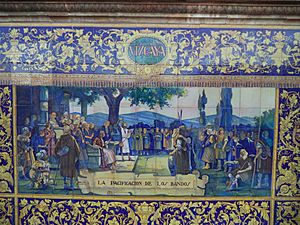War of the Bands facts for kids
The War of the Bands was a long series of fights between powerful families and their followers in the western Basque Country, Gascony, and Navarre during the Late Middle Ages. These fights were like a big, ongoing family feud.
The war gets its name from the groups of families and their armed supporters, called bandos (bands). These bands constantly fought for power and honor. The wars only stopped when the kings and queens, like Ferdinand II of Aragon and Isabella of Castile (known as the Catholic Monarchs), took strong control.
Contents
Why the Wars Started
The wars began partly because the Castilian Civil War made the government weak. The ruling family, the House of Trastámara, lost much of its power. This made it easier for local groups to fight.
Also, the area called the Seniory of Biscay became part of Castile around 1379. This change made the region even more chaotic.
Towns and Noble Families
As towns like Bilbao and Bermeo grew, rich families in these towns started fighting for control. At the same time, noble families in the countryside, who lived in strong castles, had old feuds that went back hundreds of years. For example, the Legizamon and Zamudiano families had been enemies since 1270. Many smaller noble families were pulled into these big feuds through marriage.
Early Fights and Feuds
In 1362, the Legizamon and Zurbarán families fought in the streets of Bilbao. They fought again in Bermeo in 1413. Their fighting continued until 1433 without stopping. The Basurto family, who had argued with the Legizamon over fishing rights, joined the Zurbarán side.
Fights in towns were often less deadly than big battles in the countryside. For instance, only five men died in a fight in Bilbao in 1440. Ten men died in Bermeo in 1443.
Big Battles and New Enemies
In 1413, a private war started between Juan de Sant Pedro and the Navarrese families Espeleta and Alzate. After the leader of the Alzate family and his son were killed, Lord Fernando of the Gamboa family married his son to the Alzate daughter. He then attacked Juan de Sant Pedro to get revenge for his new daughter-in-law's family. Lord Fernando was defeated and killed, and 150 men died in that battle.
Around 1420, the Gamboinos attacked the Oñaz family. On Christmas, the Oñaz family's home was set on fire, and their leader plus nine others died. The Gamboinos then destroyed the Oñaz family's lands. But the Oñaz family's friends came to help. The Lezcano family, who were allies of the Oñaz, attacked the Balda family, who were allies of the Gamboinos, and killed their leader. This created a whole new set of feuds.
The Gamboinos and Balda families fought against the Oñaz and Lezcano families at Zumarraga in 1446. The Oñaz side won and burned the Gamboino fortress at Azkoitia. Seventy men and twelve leaders were killed. These families, with even more allies, fought again in 1447 and 1448.
Royal Power Steps In
As early as 1390, royal groups called hermandades (brotherhoods) tried to stop the fighting in Biscay. These groups had money from royal lands.
In 1415, the corregidor (a royal governor) took wheat from Biscay to another region, which made the people of Biscay rebel. They were defeated, and the wheat transfers continued. In 1442, the hermandades successfully brought peace to Bilbao and Mondragón, but it did not last.
Finally, in 1457, the war between the Gamboinos and the Oñaz ended suddenly. The hermandades rebelled against both families. They took over their homes and forced their leaders out of Guipúzcoa. This showed that the royal power was becoming strong enough to stop these long-running feuds.
See also
 In Spanish: Guerras de bandos para niños
In Spanish: Guerras de bandos para niños


